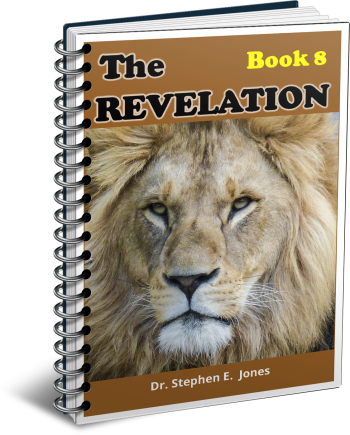Latest Posts
View the latest posts in an easy-to-read list format, with filtering options.

A study of Revelation 20-22. This is book 8 of an 8 part book series.
Category - Bible Commentaries

Revelation 21:9 says,
9 And one of the seven angels who had the seven bowls full of the seven last plagues, came and spoke with me, saying, “Come here, I shall show you the bride, the wife of the Lamb.”
The phrase, “the bride, the wife of the Lamb” carries a numeric value of 144 x 20. As we will see later, the number 144 is related to the 144,000 seen earlier, as well as the measure of the city’s wall, which is 144 cubits (Rev. 21:17, KJV). The number twenty is the biblical number of redemption. Putting together 144 and 20, the underlying revelation presented here is that the overcomers have been redeemed.
John does not tell us specifically which of the seven angels gave him this revelation. My own personal word from the Lord tells me that it is the seventh angel, called the Angel of the Approaching Fullness of God. This is the angel who was assigned to pour out the last plague into the air in Rev. 16:17 with the word, “It is done.”
The fall of Babylon anticipates the New Jerusalem that replaces it. This angel’s positive role, as his name implies, is to reveal “the Approaching Fullness of God.” In this case, it is to reveal the New Jerusalem. His calling is not only to show us “the wife of the Lamb,” but to show her filled with the Fullness of God.
A few verses earlier, in Rev. 21:6, we saw a hint that this angel was about to step forward with revelation for John, for the voice from the throne said, “It is done.” This is the same statement given by the angel in Rev. 16:17, where it referred to the overthrow of Babylon.
That was the negative work. In Rev. 21:6 the word refers to the positive work of replacing Mystery Babylon with New Jerusalem and, as the word specifically says, replacing the old panta with the new.
Revelation 21:10, 11 says,
10 And he carried me away in the Spirit to a great and high mountain, and showed me the holy city, Jerusalem, coming down out of heaven from God, 11 having the glory of God. Her brilliance was like a very costly stone, as a stone of crystal-clear jasper.
Being carried away (or conveyed) in the Spirit here does not necessarily mean that his body was transported to an earthly mountaintop. Such an experience can, indeed, happen, as with Ezekiel, who was conveyed to the exiles of the House of Israel in Assyria (Ezekiel 3:14, 15). But John’s experience was not physical. Rather, his experience was similar to an earlier one in Rev. 17:3, where John had been carried away, this time “into a wilderness,” to view the great harlot. In Revelation 21 John is carried away in the Spirit to a high mountain to view the Lamb’s wife. First the counterfeit (that is, the harlot) was revealed, and then the true bride was revealed.
John’s spirit was conveyed to a mountain in the spiritual realm, where he could be in a position to view the Lamb’s wife coming, or emerging, out of heaven and into the earthly realm. There John saw the holy city, no longer called “new Jerusalem,” as in verse 2, but simply “Jerusalem.” In other words, this city (at this point) is the true and only Jerusalem, fulfilling the positive prophecies given to that city by the prophets.
The earthly Jerusalem, by this time, has been cast out, even as Hagar was to be cast out (Gal. 4:25, 30), leaving only Sarah, the mother of all Kingdom inheritors to be revealed in all her glory. There is no more competition at this point in time, for the new Jerusalem has been identified and certified as the wife of the Lamb. Earlier prophecies of God’s choice had gone largely unheeded, because the children of the flesh had wanted their own mother (“Hagar”) to be the chosen wife.
But the angel shows John the chosen wife of the Lamb “having the glory of God” (Rev. 21:11). In past generations, the glory of God had rested over the ark of the covenant, which had been given first to Shiloh and later to the earthly Jerusalem. When the glory departed from each of those cities on account of their fleshly corruption, the full glory is not seen again until the new Jerusalem emerges with that same glory.
Her glory is described as “crystal-clear jasper” in order to connect her with the One sitting on the throne in Rev. 4:3, who also appeared “like a jasper stone.” The wife of the Lamb, then, is given the same glory as her Husband.
Revelation 21:12 says,
12 It had a great and high wall, with twelve gates, and at the gates twelve angels; and names were written on them, which are those of the twelve tribes of the sons of Israel.
The predominance of the number twelve suggests that the city is fully characterized by divine government. There is no rebellion or disagreement. She is not merely under divine government—as if she might be under constraint for fear of straying—but rather, she is the executor of divine government. She fulfills the original purpose of marriage as “bone of my bones, and flesh of my flesh” (Gen. 2:23).
Zech. 2:5 describes the wall of the new Jerusalem as “a wall of fire.” His metaphor reveals that a wall is a boundary, and in the case of this city, it is a moral boundary established by the “fiery law” of God (Deut. 33:2, KJV). John does not mention the fire, but tells us in verse 17 that it is 144 cubits high. This identifies the wall with the overcomers, made from the same “living stones” that are found in the temple (1 Peter 2:5).
Each living stone carries the fire and glory of God. As the law is written upon their hearts, all that they are and do comes out of the nature of Christ. This is actually referenced in Deut. 33:2, 3 (KJV), where we read,
2 … From His hand went a fiery law for them. 3 Yea, He loved the people; all His saints are in Thy hand; and they sat down at Thy feet; everyone shall receive of Thy words.
God’s hand is pictured sending forth “a fiery law,” and in His hand are the saints. In other words, the saints of God are identified with the fiery law itself, and the fact that “everyone shall receive of Thy words” shows that these saints have heard the word and that the law is written in their hearts. This, then, qualifies them to rule others according to the mind of God. So the wall of Jerusalem is composed of living stones in whose hearts are written the divine law. They are pictured as the wall—the standard of morality, the moral boundary of the city.
Revelation 21:13, 14 continues,
13 There were three gates on the east and three gates on the north and three gates on the south and three gates on the west. 14 And the wall of the city had twelve foundation stones, and on them were the twelve names of the twelve apostles of the Lamb.
If we go by the description of the gates in Ezekiel 48, we see that the specific tribes of Israel are associated with the gates in this way:
North Gates (Ezekiel 48:31):
Reuben
Judah
Levi
East Gates (Ezekiel 48:32):
Joseph
Benjamin
Dan
South Gates (Ezekiel 48:33):
Simeon
Issachar
Zebulun
West Gates (Ezekiel 48:34):
Gad
Asher
Naphtali
We have no biblical statements regarding the positions of the twelve apostles who represent each of the tribes. We can be certain only that the apostles represent the tribes, because they believe in Christ. Matt. 19:28 says,
28 And Jesus said to them, “Truly I say to you, that you who have followed Me, in the regeneration when the Son of Man will sit on His glorious throne, you also shall sit upon twelve thrones, judging the twelve tribes of Israel.”
The purpose of a city wall is not to keep people out, but to restrict their access to the city by channeling them through the gates. This protects the city and its inhabitants from the wicked who may wish to destroy through invasion or to infiltrate the city for nefarious purposes. Jesus said in John 10:1, 2,
1 “Truly, truly, I say to you, he who does not enter by the door into the fold of the sheep, but climbs up some other way, he is a thief and a robber. 2 But he who enters by the door is a shepherd of the sheep”… 7 Jesus therefore said to them again, “Truly, truly, I say to you, I am the door of the sheep.”
This principle applies to the walls and gates of the heavenly Jerusalem, which, like the earthly city, had twelve gates, or doors. Jesus is the door, but He manifests Himself in twelve ways, each gate associated with a different tribe of Israel and with the twelve apostles (Rev. 21:14).
Hence, Jesus is all twelve gates, but each gate is a different governmental administration that is pictured by the twelve apostles and the twelve tribes of Israel. Yet all serve the same basic purpose as gatekeepers that ensure that only those who have true faith in Christ are able to enter the city.